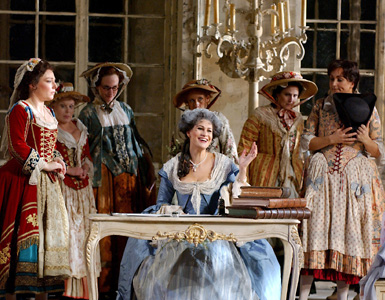Marriage of Figaro, The, is a comic opera in four acts by the Austrian composer Wolfgang Amadeus Mozart. Its Italian title is Le Nozze di Figaro. The libretto (text), in Italian, was written by Lorenzo da Ponte and based on the French comedy The Marriage of Figaro (1778) by Pierre de Beaumarchais. The opera was first performed in Vienna on May 1, 1786.

In 1775, Beaumarchais had written another comedy, The Barber of Seville. The Marriage of Figaro is its sequel. The Italian composer Giovanni Paisiello had already composed an opera based on The Barber of Seville by the time that Mozart’s adaptation of The Marriage of Figaro appeared. Eventually, the popularity of Paisiello’s opera was surpassed by Gioachino Rossini’s The Barber of Seville, which premiered in 1816.
The plot of The Marriage of Figaro follows the action begun in The Barber of Seville. It takes place in Count Almaviva’s castle near Seville, in the late 1700’s. The opera describes the problems that develop when Figaro, valet to Count Almaviva, tries to marry Susanna, maid to Countess Almaviva.
Figaro and Susanna are first seen in a room in Count Almaviva’s castle, getting ready for their wedding. Susanna realizes that their room is too close to that of the count, who wants Susanna to be his mistress. Meanwhile, Dr. Bartolo, the countess’s former guardian, and his housekeeper Marcellina are determined to stop the wedding and make Figaro abide by an agreement that he would marry Marcellina if he failed to repay a loan. In the next scene, the count’s page Cherubino tells Susanna of his hopeless love for the countess.
Loading the player...The Marriage of Figaro (aria)
A series of farcical situations follows when the count appears and proceeds to flirt with Susanna. Cherubino hides. The count hides when Don Basilio enters and discloses Cherubino’s love for the countess. At this, the count comes out of hiding and tells both Susanna and Basilio that he saw Cherubino with the gardener’s daughter Barbarina. He pulls back a covering to reveal Cherubino’s hiding place. Then, realizing that the page has overheard him indiscreetly chatting to Susanna, he packs the lad off to the army.
In a series of further comic complications, Figaro is revealed to be Marcellina’s long-lost son and therefore does not have to marry her; Figaro’s own wedding to Susanna goes ahead as planned; and an elaborate plot is hatched to trick the count. A letter written by Susanna but composed by the countess lures the count to a rendezvous after dark in the garden. In a final scene of multiple disguises, the count woos a woman whom he thinks is Susanna, only to discover that she is in fact his wife. Humbled, he begs forgiveness, and the opera ends in general rejoicing.
Operagoers have praised The Marriage of Figaro for its vivid, realistic characters. Unlike many opera composers of the time, Mozart relied far more on ensembles than on arias to develop his characters. There are, however, three wonderful arias for Figaro, notably the stirring “Non piu andrai,” in which Figaro tells young Cherubino what to expect as the page is about to embark on his enforced military career. Another highlight comes in Act II, where the lovestruck Cherubino addresses a song to the countess and Susanna, beginning with the words “Voi che sapete che cosa e amor” (“You who know what love is”). Susanna sings an exquisite soliloquy in Act IV, and in Act III, the Countess sings “Dove sono,” lamenting the loss of the Count’s love, one of the most beautiful and moving melodies in any Mozart opera.
